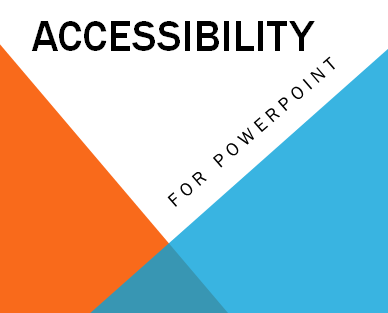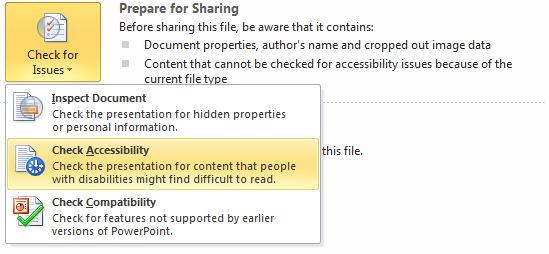Whether you are showing your presentation to your face-to-face classroom, or uploading your presentation into your online class for student reference, or setting up a presentation for a meeting — keep accessibility in mind.
Creating accessible presentations will benefit all of your students, not just those with disabilities.
Check out these tips for making an accessible PowerPoint presentation:
1. Take Advantage of PowerPoint Features
- Use an Accessible Slide Layout:
“Using these templates correctly will ensure that your files have correctly-structured headings and lists, proper reading order, etc. The correct use of slide layouts is probably the most significant thing you can do to ensure that your content is accessible.” (webaim.org)
- Outline:
- Make the outline available with the PowerPoint presentation.
- Notes:
- Add text based notes to slides to include “speaker” information.
2. Design for Readability
- Each slide should have a unique title.
- Make sure font size is readable when projected.
- Don’t crowd the slide:Use contrast.
- Limit words.
- Use simple language.
- Avoid automatic slide transactions.
- Limit animations.
3. Use Alt Tags
- 2010:
- Right-click the image or object, and then click Format.
- Click Alt Text.
- Enter a description of the image or object into the Title and Description text boxes.
- 2013:
- Select the image or object, the Format Picture Tools menu opens.
- On the right side under Format Picture, select the Layout and Properties icon.
- Select ALT TEXT to display the text boxes used to describe the picture.
4. Update URL Text Field
- Hyperlink text should be a clear description of the link destination:
- Right-click Hyperlink to open the hyperlink dialog box.
- Update the Text to display box and select OK.
5. Check Your Content
- Check reading order of slides:
- On the Home tab, in the Drawing group, click Arrange and then choose Selection Pane.
- The Selection Pane lists the objects on the slide. Objects will be read beginning with the bottom list item and ending with the top list item.
- Correct any out of order items using the Re-order arrows on the bottom of the pane.
- All embedded video is captioned or has a transcript.
- Ensure a transcript is included for embedded audio.
- Use the Check Accessibility feature .
6. Use Simple Table Structure or Don’t Use Tables
- According to Microsoft.com: “Use simple table structure…add alt text to describe the table, and having clear column headings can help provide context and assist navigation of the table’s content.”
- According to webaim.org: “There is not a way in PowerPoint to add a table that can be read by a screen reader. “
- Need to use tables?
- Save your presentation as a .pdf, and add the accessibility information using Acrobat Pro.
7. Export to PDF
“PDF is often the best format to display PowerPoint presentations on the web. The file size is relatively small, distracting slide transitions are removed, and everyone has a PDF reader. Most importantly, heading structure and other accessibility information will remain intact if you export the file correctly.” (webaim.org)



